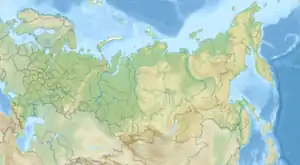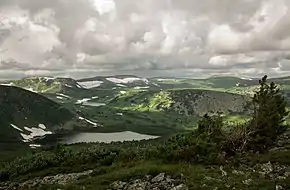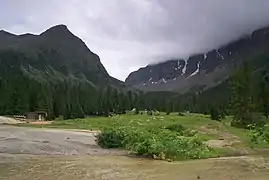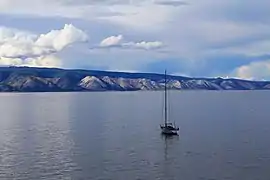| South Siberian Mountains | |
|---|---|
| Южно-Сибирские горы | |
 Sunset over the Kuznetsk Alatau | |
| Highest point | |
| Peak | Belukha Mountain |
| Elevation | 4,506 m (14,783 ft) |
| Coordinates | 51°45′N 101°00′E / 51.750°N 101.000°E |
| Dimensions | |
| Length | 3,000 km (1,900 mi) E/W |
| Area | 1,500,000 square kilometres (580,000 sq mi) |
| Geography | |
 South Siberian Mountains Location in Russia | |
| Location | Altai Republic, Altai Territory, Kemerovo Oblast, Tuva, Khakassia, Krasnoyarsk Krai, Irkutsk Oblast, Buryatia, Transbaikal Krai |
| Geology | |
| Orogeny | Alpine orogeny |
The South Siberian Mountains (Russian: Южно-Сибирские горы, romanized: Yuzhno-Sibirskiye Gory) are one of the largest mountain systems of the Russian Federation. The total area of the system of mountain ranges is more than 1.5 million km². The South Siberian Mountains are located in the Siberian and Far Eastern Federal Districts of Russia, as well as partly in Mongolia.[1] The territory of the mountain system is one of the Great Russian Regions.
Geography
The system is composed of a number of ranges aligned in an east–west direction stretching for almost 3,000 kilometres (1,900 mi). Part of them are near the border with Mongolia and China, while others rise further north. To the south the South Siberian ranges merge with the Mongolian and Chinese mountain chains and plateaus. In the west lies the Dzungarian Basin and to the east the Mongolian Plateau. To the north the South Siberian Mountains merge with the West Siberian Lowland and the Central Siberian Plateau, both on the Russian side. To the southeast the Baikal Range is separated from the Eastern Sayan by the Baikal Rift Zone and the Tunkin Depression. To the northeast of its eastern end the South Siberian mountain system merges with the East Siberian Mountains.[2]
Geologically the mountains of the system underwent a process of rejuvenation during the Alpine orogeny. Earthquakes are common all across the area of the system.[3]
Owing to the mountainous terrain, large swathes of the South Siberian system are uninhabited. The main cities of the vast region are, from west to east: Krasnoyarsk, Angarsk, Irkutsk, Ulan-Ude and Chita.[4]
Ranges
- Salair Ridge
- Kuznetsk Alatau
- Sayan Mountains ( Western and Eastern )
- Tannu Ola
- Baikal Range
- Khamar Daban
- Ulan-Burgas
- Barguzin Range
- Yablonoi Mountains
- Chersky Range (Transbaikalia)
- Olyokma-Stanovik
- Khentei-Daur Highlands
- Ikat Range
- Vitim Plateau
- Selenga Highlands
- Stanovoy Highlands
- North Baikal Highlands
- Patom Highlands
- Olyokma-Chara Plateau
- Aldan Highlands
- Stanovoy Range
- Primorsky Range
 South Siberian Mountains, Kuznetsk Alatau.
South Siberian Mountains, Kuznetsk Alatau. View of the Sayan Range in Northern Tuva.
View of the Sayan Range in Northern Tuva. The Primorsky Range rising above the western shores of Lake Baikal.
The Primorsky Range rising above the western shores of Lake Baikal.
Hydrography
Some of the main rivers of Siberia have their origin in the South Siberian mountain system, such as the Lena, Irtysh, the Yenisei and the Ob River. Other rivers of the area are the Argun, Tom, Shilka, Selenga, Katun and the Biya River. The great Lake Baikal is the most well-known lake of the region. Other much smaller lakes are Lake Teletskoye, Lake Markakol, Lake Todzha (Azas), Baunt and Noyon-Khol.[2]
See also
References
- ↑ Mountains of South Siberia in the book: Gvozdetsky N. A., Mikhailov N. I. Physical geography of the USSR. M., Thought, 1978.
- 1 2 (Mountains of South Siberia) (in Russian) from: Gvozdetsky N. A., Mikhailov N. I. Physical geography of the USSR. M., Thought, 1978.
- ↑ Altai-Sayan Mountain Country (in Russian)
- ↑ Google Earth